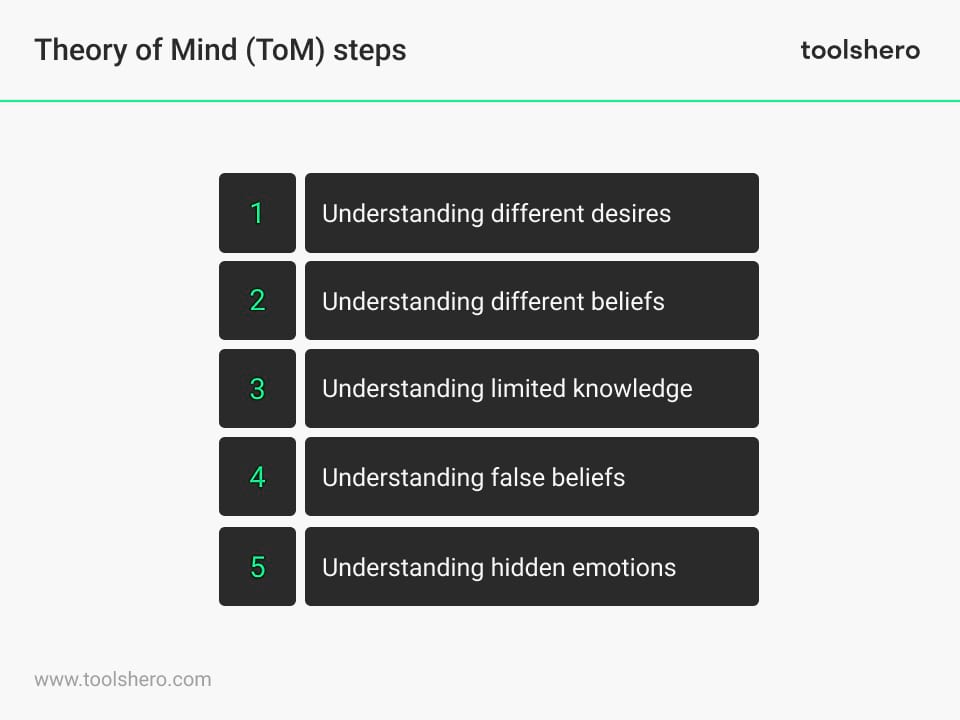Theory of Mind (ToM) explained

Theory of Mind (ToM): this article explains the Theory of Mind (ToM) in a practical way. The article contains the definition of this term, information about the origin and development of the theory, and a practical example. Enjoy reading!
What is Theory of Mind and why is it important?
The Theory of Mind (ToM) is a concept from psychology, psychiatry and the philosophy of mind. The concept focuses on understanding people’s perspective and inner world.
It is important because it’s the ability to infer and understand another’s mental state, and refers to the ability to attribute people’s mental states to themselves and others, such as beliefs, desires, intentions, and emotions.
The theory recognizes that these states can vary from person to person. Developing a ToM is an essential prerequisite for developing empathy and a successful social interaction or relationship.
What is theory of mind example?
The theory of mind covers various disciplines, such as psychology and psychiatry. The goal of the theory is to uncover the mechanisms underlying the understanding of the human mind and its implications for human behavior.
Everyone develops their own theory of mind. Often this happens in example in early childhood, during the toddler and preschool years (2 to 3 years old). At this age, children begin to recognize and name their own emotions and thoughts.
Through this self-awareness, they gradually acquire the ability to recognize and name these feelings in others. They also learn to deal with false beliefs in this phase, developing an understanding of falsehoods and deceit: they learn to fool others.
This theory of mind plays a crucial role in everyday social interactions between individuals. By analyzing, judging and interpreting the mental states of others, people can better make sense of their behavior. The field of developmental psychology has made significant contributions to understanding theory of mind among children.
Theory of Mind: False belief task example
This was done using methods such as the false belief task. This task involves a scenario, where a character, such as Sally in example, places an object in a basket and then leaves the room. Another character, such as Anne, then takes the object from the basket and puts it in another location while Sally is absent.
When Sally returns, children with developed theory of mind may deduce that Sally will believe the object is still in its original spot, despite their knowledge of the object’s displacement. This ability to recognize and understand the beliefs of others is at the heart of the theory of mind. Developing this theory has been a major milestone in the study of cognitive development.
Autism Spectrum Disorders
ToM is a common characteristic of developing boys and girls. Nevertheless, limitations are regularly observed in its development. This is especially the case with young people with a form of autism.
Autistic children may have difficulty describing mental states to themselves and others. Impairment in theory of mind leads to abnormalities in social interactions and empathy compared to people who do not have this disorder.
Simon Baron-Cohen, a respected researcher, has done extensive research on this. He highlights the differences in their cognitive processes.
Neurological aspects of the theory of mind
These differences came to light by applying methods such as neuroimaging. These studies demonstrate the specific brain regions involved in theory of mind, such as the medial prefrontal cortex (mPFC) and the posterior superior temporal sulcus (pSTS).
Injuries and other limitations in these areas can also lead to difficulties in developing a theory of mind.
Theory of mind among animals
The theory of mind does not only apply to humans. Other animals also develop the ability to understand the mental states of other animals.
For example, theory of mind research with orangutans and chimpanzees have shown that they understand the difference between accidental and deliberate actions. That points to a form of theory of mind among animals.
What are the 5 stages of the theory of mind?
Several studies have shown that children generally go through five different stages in developing the theory of mind. These are briefly described below.

Figure 1 – Theory of mind steps and stages
Stage 1: understanding that people can have different desires
During these early stages, children begin to understand the reasons why other people sometimes want something. These desires can vary from person to person. They develop the realization that not everyone wants the same things as they do.
An example of this is a child who likes to play outside who realizes that his or her friend prefers to play inside.
Stage 2: understanding that people have different beliefs
In this stage, children begin to understand that different people may have different beliefs about the same situation or event. They realize that some people may believe something that does not correspond to reality.
For example, a child can understand that his or her friend thinks there is candy in a box in the cupboard, while the child knows that it only contains toys.
Stage 3: understanding that people can have limited knowledge
In this stage, children learn that people do not always have the information they have. They learn that some people can therefore believe something based on limited knowledge.
A child can understand that another child does not know which gift is in a closed package, because he or she looked when the gift was put in the box and the other child did not.
Stage 4: understanding that people can have false beliefs
In this stage, children learn that some people may have false beliefs about the world around them. They understand that someone can believe something that does not correspond to reality, even if they themselves know that it is not true.
For example, a child may understand that a character in a book thinks there is a monster under the bed, when the child knows there is no monster at all.
Stage 5: understanding that people can hide their emotions
In this stage, children learn that some people hide their emotions and that they feel differently than how they behave. They understand that someone can act happy, but is actually sad.
A child can understand that a friend is sad, even if he smiles and pretends nothing is wrong.
Different development speeds
It is important to mention that the development of theory of mind is not always linear. Theory of mind develops at different speeds and some children may have difficulty understanding social situations.
It is generally assumed that children from the age of 4 can pass all theory of mind tasks. These skills then continue to develop and improve late into adolescence and adulthood.
It is also believed that some children are better at understanding what other people are thinking and feeling. They generally have stronger social skills.
Critical perspectives on the theory of mind
While widely adopted in psychology and psychiatry, there are also many critical perspectives on the phenomenon and alternative approaches within the research field of cognitive development. These perspectives challenge existing views and emphasize other aspects of social interaction and social understanding.
One of these challenges to the theory of mind is the role of phenomenology. Phenomenology is an approach that focuses on the subjective experience and perception of children and individuals in general. Within this perspective, it is argued that understanding others is based not only on the ability to attribute mental states, but also on understanding people’s personal experience and meaning making.
Another criticism has been directed at the supposed role of mindreading in understanding others. Some researchers argue that mindreading is not the only way other people are understood. They emphasize empathy and social intuition as crucial elements in understanding the feelings and emotions of others.
Applications of the theory of mind
Theory of mind has various practical applications in various domains. These range from education to clinical psychology. Understanding the perceptions and mental states of others can help us navigate social interactions and understand human behavior.
Some well-known applications of the theory are briefly explained below.
Education
In education, this theory is important for understanding and improving empathy among children. Making children aware that other people have different thoughts and emotions can help them understand how others feel and react. That can improve the development of empathy and their social skills.
Clinical psychology
Clinical psychology suggests that theory of mind is important for understanding disorders related to social understanding, such as autism spectrum disorders. By testing the theory in people with autism, researchers can gain a better understanding of how impairment affects this phenomenon. This can lead to more effective interventions and treatments.
Communication
In communication, this theory is important for developing programs for more effective communication and language development. The ability to understand other people’s perspectives, thoughts and intentions enables people to better tailor their own messages to the needs of other people.
Social and emotional development
The theory of mind is closely linked to the concepts of social and emotional intelligence. The ability to understand the thoughts and emotions of others enables humans to show empathy, collaborate effectively, and build social relationships.
Artificial Intelligence (AI)
Finally, this theory has implications for the development of artificial intelligence and robotics. Enabling robots to understand people’s mental states will allow them to more closely mimic natural and social interactions. This leads to improved user experiences and applications of robotics in domains such as healthcare, education and entertainment.
It’s Your Turn
What do you think? Do you recognize the explanation about the theory of mind? How do you think this theory can improve our understanding of social interactions? Have you ever experienced situations where you flawlessly sensed someone else’s mental state? If so, can you give an example? What do you think are new, creative applications of this theory? Do you think this theory is important in the development of artificial intelligence (AI) and the development of brain chips by companies such as Elon Musk’s Neuralink? Do you have other comments or tips?
Share your experience and knowledge in the comments box below.
More information
- Carlson, S. M., Koenig, M. A., & Harms, M. B. (2013). Theory of mind. Wiley Interdisciplinary Reviews: Cognitive Science, 4(4), 391-402.
- Doody, G. A., Götz, M., Johnstone, E. C., Frith, C. D., & Owens, D. C. (1998). Theory of mind and psychoses. Psychological medicine, 28(2), 397-405.
- Frith, C., & Frith, U. (2005). Theory of mind. Current biology, 15(17), R644-R645.
- Wellman, H. M. (1992). The child’s theory of mind. The MIT Press.
How to cite this article:
Janse, B. (2023). Theory of Mind (ToM). Retrieved [insert date] from Toolshero: https://www.toolshero.com/psychology/theory-of-mind/
Original publication date: 08/08/2023 | Last update: 08/08/2023
Add a link to this page on your website:
<a href=” https://www.toolshero.com/psychology/theory-of-mind/”> Toolshero: Theory of Mind (ToM)</a>







